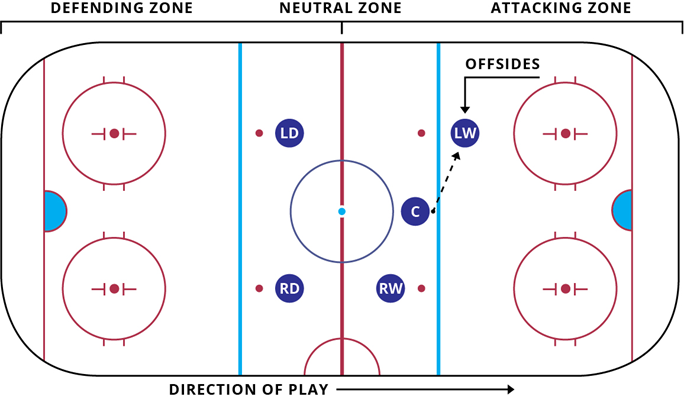Ice hockey is a fast-paced, exciting sport, but some of its rules can be confusing for new fans and players. One of the most commonly misunderstood rules in hockey is the offside rule. This guide will explain everything you need to know about offside in ice hockey, including what it is, how it’s enforced, and why it’s essential for the game. By understanding the offside rule, you’ll gain a deeper appreciation for the strategy and flow of hockey and be able to follow the game with more confidence.
What is the Offside Rule in Ice Hockey?
The offside rule in ice hockey is a regulation that dictates the movement of players in relation to the puck and the blue lines on the rink. The rule aims to maintain fair play and prevent players from gaining an unfair advantage by positioning themselves too close to the opponent’s goal before the puck arrives.
In simple terms, a player cannot enter the opponent’s zone (the area between the blue line and the goal line) before the puck crosses the blue line. If a player enters the offensive zone before the puck, they are considered “offside,” and the play is stopped.
Understanding the Ice Hockey Rink and Zones
To fully grasp the offside rule, it helps to understand the layout of an ice hockey rink:
- Neutral Zone: The area between the two blue lines. This is the center portion of the rink where teams often battle for puck control.
- Defensive Zone: The area between the blue line and the goal line, closest to a team’s own net.
- Offensive Zone: The area between the opponent’s blue line and goal line. This is where teams attempt to score against their opponent’s goaltender.
The blue lines serve as markers that separate the defensive and offensive zones from the neutral zone. The puck must cross the blue line into the offensive zone before any attacking player does for the play to be considered “on-side.”
How the Offside Rule Works in Ice Hockey
Here’s a step-by-step look at how the offside rule is applied during a hockey game:
- Puck Enters First: For a play to be onside, the puck must enter the offensive zone before any attacking player. If a player crosses the blue line into the offensive zone before the puck, they are offside.
- Position of Skates: A player is considered offside if both of their skates cross the blue line before the puck. If one skate is still on or behind the blue line, they are not offside.
- Delayed Offside: In certain situations, an offside may be considered “delayed.” This means that if the attacking team accidentally crosses the blue line before the puck but then leaves the offensive zone, they can “tag up” or touch the blue line to avoid an offside call. Once they tag up, the offside is negated, and they can re-enter the offensive zone legally.
- Offside Whistle: When an offside occurs, the officials blow the whistle to stop play. The faceoff is then held just outside the offensive zone in the neutral zone, near the blue line where the offside occurred.
Examples of Offside Situations
Understanding offside can be easier with a few examples:
- Example 1: Player A is skating towards the opponent’s blue line. They pass the puck to Player B, who receives the puck just outside the blue line. Player A skates into the offensive zone before Player B crosses the blue line with the puck. This is an offside violation since Player A entered the zone before the puck.
- Example 2: Player A and Player B both skate towards the opponent’s blue line. Player A has the puck and crosses the blue line first, with Player B following right behind. In this case, there is no offside violation because the puck entered the offensive zone before the attacking players.
- Example 3: During a fast break, Player A accidentally crosses the blue line before the puck. Recognizing their mistake, Player A skates back out to the neutral zone, touching the blue line to “tag up” before re-entering. This is not an offside violation, as Player A tagged up, allowing play to continue.
Delayed Offside in Ice Hockey
The delayed offside rule is a provision that allows play to continue under certain conditions, even if an offside has occurred. When a delayed offside is in effect, the attacking players must clear the offensive zone and “tag up” by skating back to the blue line before they can legally re-enter the zone. Here’s how it works:
- Delayed Whistle: When a player goes offside but doesn’t touch the puck, the linesman will signal a delayed offside by holding up their arm.
- Tagging Up: All attacking players who are offside must leave the offensive zone by crossing the blue line into the neutral zone. Once they are outside the offensive zone, they can re-enter, and the delayed offside is cleared.
- Re-Entry: After tagging up, the players can legally re-enter the offensive zone without being offside.
This rule allows the game to flow more smoothly, reducing stoppages and giving attacking teams a chance to recover from accidental offside infractions.
Why the Offside Rule is Important in Ice Hockey
The offside rule plays a crucial role in maintaining a fair, balanced, and strategic game. Here’s why it matters:
- Prevents Goal-Hanging: Without the offside rule, players could position themselves near the opponent’s goal, waiting for an easy pass to score. This would lead to less structured play and increase the chances of scoring without skillful gameplay.
- Promotes Team Play: Offside encourages teams to work together to move the puck up the ice. Each player must be aware of their positioning, helping to create a more strategic and coordinated effort.
- Maintains Game Flow: By enforcing offside, hockey maintains a natural back-and-forth flow, preventing attacking players from simply camping out near the opponent’s goal.
- Allows Defenders Time to Recover: Offside provides defenders a chance to reset and regain positioning, preventing the offense from gaining too large of an advantage.
Common Misconceptions About the Offside Rule
The offside rule can be confusing, especially for those new to the sport. Here are some common misconceptions:
- Both Skates Must Be Over the Line: A player is only offside if both skates completely cross the blue line before the puck. If one skate is on the line, they are still onside.
- Offside Doesn’t Mean a Penalty: Offside is not a penalty; it simply stops play and results in a faceoff outside the offensive zone.
- Delayed Offside Isn’t the Same as Offside: In delayed offside, play continues until the puck is touched by an offside player, allowing the offensive team to avoid the stoppage by clearing the zone.
- Offside Applies Only to the Offensive Zone: Offside is only enforced when a player enters the offensive zone ahead of the puck. It doesn’t apply when entering the neutral or defensive zones.
How Officials Enforce the Offside Rule
Offside is enforced by the linesmen, who are officials specifically responsible for monitoring offsides, icing, and faceoffs. Here’s how they do it:
- Positioning: Linesmen position themselves along the blue lines to get a clear view of players entering and exiting the offensive zone.
- Signals: When a player is offside, the linesman will blow the whistle and raise their arm to signal the infraction. For a delayed offside, they hold one arm out horizontally until the offside players clear the zone.
- Communication: Linesmen communicate with each other and with the referee to ensure consistency in offside calls and enforcement.
Officials are trained to identify offside situations quickly and accurately, ensuring that the rule is applied consistently throughout the game.
Advanced Concepts: Intentional Offside
An intentional offside occurs when a player deliberately enters the offensive zone before the puck with the intent of gaining an advantage. In this situation, the linesman may blow the whistle, and the ensuing faceoff is placed in the defensive zone of the offending team rather than just outside the offensive zone.
This rule discourages players from trying to manipulate the offside rule to gain an advantage and promotes fair play.
Offside Challenges in Professional Hockey
In professional hockey leagues, coaches can challenge an offside call if they believe an official made a mistake. This is often done by reviewing video footage, especially if an offside led directly to a goal. Here’s how it works:
- Challenge Procedure: Coaches can request an offside review if they believe the play leading to a goal was offside. The referees review the footage to confirm or overturn the call.
- Consequences of a Failed Challenge: If a coach’s challenge fails, the team may lose a timeout or face a minor penalty in some leagues, such as the NHL.
- Impact on Game Flow: Offside challenges can slow down the game, but they also add an element of strategy and ensure fairness.
FAQs
1. What happens if a player is offside in hockey?
- If a player is offside, play is stopped, and a faceoff is conducted in the neutral zone outside the offensive zone. This reset gives the defending team an advantage.
2. Can a player be offside if they have possession of the puck?
- No, a player cannot be offside if they carry the puck into the offensive zone. The offside rule applies only to players entering the zone without the puck.
3. What is a delayed offside?
- A delayed offside allows attacking players to “tag up” by clearing the offensive zone before re-entering. If they do so before touching the puck, the offside is nullified, and play continues.
4. Is offside a penalty in ice hockey?
- No, offside is not a penalty. It simply stops play and results in a neutral zone faceoff. However, an intentional offside can result in a faceoff deeper in the offending team’s zone.
5. Can a coach challenge an offside call in hockey?
- Yes, in professional leagues, coaches can challenge an offside call if it leads to a goal. If the challenge is unsuccessful, the team may lose a timeout or receive a minor penalty.
6. Does offside apply in all areas of the ice?
- No, the offside rule only applies to the offensive zone, which is the area beyond the opponent’s blue line. It does not apply to the neutral or defensive zones.
Conclusion
The offside rule is fundamental to the structure, flow, and strategy of ice hockey. By ensuring that players enter the offensive zone fairly, the rule encourages teamwork, discipline, and skill. While it may seem complex initially, understanding offside helps fans and players appreciate the strategic elements of hockey. As you continue to watch or play, knowing the offside rule will allow you to follow the game more closely and enjoy the intricate details of this fast-paced sport.


